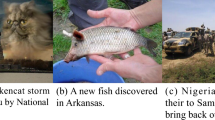Abstract
Social media platforms are inundated with an extensive volume of unverified information, most of which originates from heterogeneous data from a variety of diverse sources, spreading rapidly and widely, thereby posing a significant threat to both individuals and society. An existing challenge in multimodal fake news detection is its limitation to acquiring textual and visual data exclusively from a single source, which leads to a high level of subjectivity in news reporting, incomplete data coverage, and difficulties in adapting to the various forms and sources of fake news. In this paper, we propose a fake news detection model (MHDF) for multi-source heterogeneous data progressive fusion. Our approach begins with gathering, filtering, and cleaning data from multiple sources to create a reliable multi-source multimodal dataset, which involved obtaining reports from diverse perspectives on each event. Subsequently, progressive fusion is achieved by combining features from diverse sources. This is achieved by inputting the features obtained from the textual feature extractor and visual feature extractor into the news textual and visual feature fusion module. We also integrated sentiment features from the text into the model, allowing for multi-level feature extraction. Experimental results and analysis indicate that our approach outperforms other methods.
Access this chapter
Tax calculation will be finalised at checkout
Purchases are for personal use only
Similar content being viewed by others
References
Devlin, J., Chang, M.W., Lee, K., Toutanova, K.: BERT: pre-training of deep bidirectional transformers for language understanding (2018)
Radford, A., Narasimhan, K.: Improving language understanding by generative pre-training (2018)
Kim, Y.: Convolutional neural networks for sentence classification. Eprint Arxiv (2014)
Simonyan, K., Zisserman, A.: Very deep convolutional networks for large-scale image recognition. Comput. Sci. (2014)
Liu, Z., et al.: Swin transformer: hierarchical vision transformer using shifted windows (2021)
Wang, Y., Ma, F., Jin, Z., Yuan, Y., Jha, K.: EANN: event adversarial neural networks for multi-modal fake news detection. In: ACM SIGKDD International Conference (2018)
Khattar, D., Goud, J.S., Gupta, M., Varma, V.: MVAE: multimodal variational autoencoder for fake news detection. In: The World Wide Web Conference (2019)
Jin, Z., Cao, J., Guo, H., Zhang, Y., Luo, J.: Multimodal fusion with recurrent neural networks for rumor detection on microblogs. In: The 2017 ACM (2017)
Wu, Y., Zhan, P., Zhang, Y., Wang, L., Xu, Z.: Multimodal fusion with co-attention networks for fake news detection. In: Findings of ACL 2021 (2021)
Hua, J., Cui, X., Li, X., Tang, K., Zhu, P.: Multimodal fake news detection through data augmentation-based contrastive learning. Appl. Soft Comput. 136, 110125 (2023)
Guo, Y.: A mutual attention based multimodal fusion for fake news detection on social network. Appl. Intell. 53(12), 15 311–15 320 (2023)
Mihalcea, R., Tarau, P.: TextRank: bringing order into texts (2004)
Mikolov, T., Chen, K., Corrado, G., Dean, J.: Efficient estimation of word representations in vector space. Comput. Sci. (2013)
Su, J.: SimBERT: integrating retrieval and generation into BERT. Technical report (2020)
Hochreiter, S., Schmidhuber, J.: Long short-term memory. Neural Comput. 9(8), 1735–1780 (1997)
Author information
Authors and Affiliations
Corresponding author
Editor information
Editors and Affiliations
Rights and permissions
Copyright information
© 2024 The Author(s), under exclusive license to Springer Nature Singapore Pte Ltd.
About this paper
Cite this paper
Yu, Y., Ji, K., Gao, Y., Chen, Z., Ma, K., Wu, J. (2024). MHDF: Multi-source Heterogeneous Data Progressive Fusion for Fake News Detection. In: Yang, DN., Xie, X., Tseng, V.S., Pei, J., Huang, JW., Lin, J.CW. (eds) Advances in Knowledge Discovery and Data Mining. PAKDD 2024. Lecture Notes in Computer Science(), vol 14649. Springer, Singapore. https://doi.org/10.1007/978-981-97-2262-4_3
Download citation
DOI: https://doi.org/10.1007/978-981-97-2262-4_3
Published:
Publisher Name: Springer, Singapore
Print ISBN: 978-981-97-2264-8
Online ISBN: 978-981-97-2262-4
eBook Packages: Computer ScienceComputer Science (R0)




